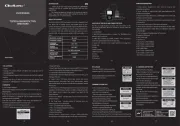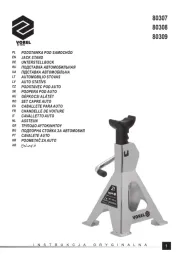Dual C 814 Handleiding
Dual
Niet gecategoriseerd
C 814
Bekijk gratis de handleiding van Dual C 814 (18 pagina’s), behorend tot de categorie Niet gecategoriseerd. Deze gids werd als nuttig beoordeeld door 151 mensen en kreeg gemiddeld 4.4 sterren uit 76 reviews. Heb je een vraag over Dual C 814 of wil je andere gebruikers van dit product iets vragen? Stel een vraag
Pagina 1/18

Service
-Anleitung
Service
Manual
lnstructions
de
Service
Dual
814
INHALT
CONTENTS
SOMMA
I
RE
2
Funktionsbeschreibung
Functional
description
Description
du
fonctionnement
4
Blockschaltbild
Bloc
diagram
Schema
de
bloc
5
Schaltbild
VViring
diagram
Schema
d'electrique
9
Printplatten
Printed
circuit
boards
Plaques
de
inscription
11
Verdrahtungsplan
VViring
schenna
Schema
de
cäble
12
Abgleichanleitung
Alignment
instructions
lnstructions
de
alignement
14
Mechanischer
Teil
Mechanical
Part
Partie
möchanique
15
Ersatzteile
mit
Replacement
with
Piece
detachees
et
vues
Explosionszeichnung
exploded
views
explosees
20
Technische
Daten
Technical
data
Caracteristiques
techniques
Dual
Gebrüder
Steidinger
GmbH
&
Co.
•
7742
St.
Georgen/Schwarzwald
920
753-2
12.2/0881
Printed
in
Germany
by
Dual
Download from www.dual.de
Not for commercial use

Funktionsbeschreibung
C
814
Wiedergabe
Die
vom
Tonkopf
kommende
Spannung
(ca.
300
1.1V
beim
Abspielen
des
DIN-Bezugpegels)
wird
zunächst
mit
TR
101
und
TR
102
verstärkt
und
mit
dem
Gegenkoppelungsnetzwerk
R
108,
R
109
und
C
108
ent-
sprechend
entzerrt.
Die
Umschaltung
der
Wiedergabeentzerrung
von
120
ps
auf
70
bis
erfolgt
durch
das
Durchschalten
von
TR
103.
Der
Wie-
dergabepegel
wird
beim
Abspielen
des
Dolby-Bezugspegels
(200
nWb/m)
mit
VR
101
an
der
Cinch-Buchse
LINE
OUT
auf
560
mV
eingestellt.
Das
Wiedergabesignal
gelangt
über
den
A
-W
-Schalter
SW
401-4
und
den
Zwischenverstärker
TR
105
über
des
MPX-Filter
L
101
an
den
Eingang
der
Dolbyschaltung
IC
101,
Pin
2.
Ist
der
Dolby-Wahlschalter
SW
302
ausgeschaltet,
wird
das
Signal
innerhalb
der
Dolbyschaltung
um
ca.
20
db
linear
verstärkt,
während
bei
eingeschaltetem
Dolbysystem
frequenz-
und
pegelabhängig
verstärkt
wird.
Mit
VR
301
wird
die
Dolby-
funktion
eingestellt.
Nur
erforderlich
beim
Austausch
von
IC
101
(siehe
Abgleichanleitung).
Das
Ausgangssignal
gelangt
von
Pin
9
(IC
101)
über
den
A
-W
-Schalter
SW
401-5
zum
Anzeigeverstärker
(TR
113),
zum
Kopfhörerverstärker
(TR
111,
TR
112),
zur
Cinchbuchse
LINE
OUT
und
über
den
A
-W
-Schalter
SW,401-6
zur
DIN-Buchse.
Damit
keine
Schaltgeräusche
an
die
Ausgangsbuchsen
gelangen,
wird
das
Eingangssignal
mit
TR
104
und
das
Ausgangssignal
mit
TR
114
stummgeschaltet.
Bei
Wiedergabe
wird
der
Aufnahmeverstärker
am
Ein-
gang
mit
TR
115
stummgeschaltet.
Aufnahme
Für
die
Aufnahme
stehen
drei
verschiedene
Quellen
zur
Verfügung.
Bei
Belegung
der
DIN-Buchse
wird
der
Line-Eingang
abgeschaltet.
Durch
das
Anschließen
eines
Mikrofones
wird
das
von
dem
Line-
oder
DIN
-En
-
gang
kommende
Signal
abgeschaltet.
Das
Mikrofonsignal
wird
mit
TR
301
und
TR
302
verstärkt,
während
das
Signal
vom
DIN-Eingang
mit
TR
116
verstärkt
wird.
Das
Line-Signal
gelangt
direkt
zum
Aus-
steuerungssteller
VR
102.
Von
hier
gelangt
es
über
den
A
-W
-Schalter
SW
401-4
an
den
Zwischenverstärker
TR
105
und
das
MPX-Filter
L
101
an
Pin
2
der
Dolbyschaltung
IC
101.
Innerhalb
des
Dolbyprozessors
verzweigt
sich
das
Signal
auf
zwei
ver-
schiedene
Ausgänge,
Pin
8
und
Pin
5
von
IC
101.
Das
vom
Dolbypro-
zess
unbeeinflußte
Signal
von
Pin
5
(Monitor)
wird
bei
der
Aufnahme
über
den
A
-W
-Schalter
SW
401-5
zum
Ausgang
LINE
OUT,
Anzeige
-
und
Kopfhörerverstärker
geführt,
das
Signal
von
Pin
8
auf
den
Auf-
nahmeverstärker
TR
106.
Mit
VR
103
wird
der
Aufsprechstrom
einge-
stellt,
der
Pegel
und
die
Entzerrung
werden
über
die
Transistoren
TR
107
bis
TR
110
(Basissignal
aktiv
High)
an
die
unterschiedlichen
Bandsorten
angepaßt.
Über
den
Sperrkreis
L
106
wird
das
Aufnahmesignal
dem
Tonkopf
zugeführt,
mit
VR
105
wird
die
Vormagnetisierung
dazuge-
mischt.
Durch
Zuschalten
der
Widerstände
R
344,
R
342
und
R
339
mit
den
Transistoren
TR
306
bis
TR
308
(Basissignal
aktiv
HIGH)
wird
der
HF-Oszillator
so
beeinflußt,
daß
sich
für
die
verschiedenen
Bandsorten
ein
optimaler
Arbeitspunkt
ergibt.
Mit
dem
Pauseschalter
SW
007
und
den
Transistoren
TR
319
und
TR
321
sowie
dem
Startschalter
SW
005
über
TR
320
und
TR
321
wird
der
Oszillator
stummgeschaltet.
Bei
Aufnahmebetrieb
wird
der
DIN-Ausgang
mit
A
-W
-Schalter
SW
401-6
vom
Monitorsignal
getrennt.
Aussteuerungsanzeige
Das
Ausgangssignal
gelangt
sowohl
bei
Aufnahme
wie
auch
bei
Wieder-
gabe
zum
Anzeigeverstärker
TR
113.
Um
die
verringerte
Aussteuerbar-
keit
bei
hohen
Frequenzen
zu
berücksichtigen,
wird
eine
Frequenzgang-
korrektur
vorgenommen
(C
140).
Die
Anhebung
bei
10
kHz
gegenüber
400
Hz
beträgt
ca.
10
db.
Mit
VR
104
wird
die
+3
db
Marke
eingestellt.
Die
Anzeige
erfolgt
mittels
zweier
VU-Meter
mit
bedämpftem
Rücklauf
IC
142).
C
814:
Description
of
functions
Playback
The
voltage
coming
from
the
sound
head
(approximately
300
blV
during
playback
of
the
DIN
reference
level)
is
first
of
all
amplified
with
TR
101
and
TR
102
and
correspondingly
equalized
with
the
negative
feedback
network
R
108,
R
109
and
C
108.
When
TR
103
becomes
forward-
biased,
this
causes
switchover
of
the
playback
equalization
from
120
p.s
to
70
s.
During
playback
of
the
Dolby
reference
level
(200
nWb/m),
the
playback
level
is
set
with
VR
101
at
the
cinch
socket
LINE
OUT
to
560
mV.
Via
the
recording/playback
switch
SW
401-4
and
the
intermediate
a
mpl
fier
TR
105,
the
playback
signal
is
routed
via
the
MPX
filter
L
101
to
the
input
of
the
Dolby
circuit
IC
101,pin
2.
If
the
Dolby
selector
switch
SW
302
is
switched
off,
the
signal
is
linear-amplified
by
approximately
Endabschaltung
Die
Information
—
Band
läuft
—
wird
von
einer
mehrpoligen
Magnet-
scheibe,
die
am
Antriebsrad
des
Zählers
befestigt
ist,
an
IC
501
gegeben.
Dieses
IC
reagiert
auf
wechselnde
magnetische
Felder.
Die
vom
IC
501
erzeugten
Impulse
gelangen
an
TR
501
und
TR
502
zur
Frequenzver-
doppelung.
Das
Signal
gelangt
an
den
Schmitt-Trigger
TR
503
und
TR
504.
Bleiben
die
Bandlaufimpulse
aus
oder
wird
DLL
betätigt,
so
löst
der
Magnet
Stopp
die
Stoppfunktion
aus,
bedingt
durch
einen
LOW
Impuls
an
der
Basis
von
TR
505.
Wird
in
der
Betriebsfunktion
PLAY
die
Funk-
tion
PAUSE
betätigt,
verhindert
TR
507
ein
Durchschalten
des
Schmitt-
Triggers.
Transistor
TR
318
erkennt
mit
der
Zenerdiode
D
304
das
Absinken
der
Versorgungsspannung
z.B.
Ausschalten
des
Geräteswährend
einer
Laufwerkfunktion.
TR
318
sperrt,
damit
wird
TR
508
leitend.
TR
508
liegt
parallel
zu
den
DLL-Kontakten
SW
004
und
SW
003.
Die
Stoppfunktion
wird
ausgeführt.
Autotape
Die
neu
auf
den
Markt
kommenden
Kassetten
verfügen
über
eine
Kenn-
zeichnung
ihrer
Bandsorte
durch
Aussparungen
an
der
Gehäuserückseite,
die
von
Kontaktfühlern
im
Gerät
abgetastet
werden
(Taste
AUTOTAPE
betätigt).
Wird
die
Taste
AUTOTAPE
eingerastet
‚erfolgt
mechanisch
die
Rückstel-
lung
einer
vorher
betätigten
Taste
der
vierfach
Bandsortenwahl
,
die
LED
AUTOTAPE
leuchtet.
Über
die
Dioden
D
134
und
D
135
werden
die
Kontaktfühler
SW
010
(Cr)
und
SW
009
(FeCr)
aktiviert.
Diese
Schalter
fühlen
die
Rückseite
der
Kassette
nach
ihren
Indenditätsaussparungen
ab
und
steuern
über
eine
Diodenmatrix
die
Bandsortenwahl
und
die
Entzerrung.
Schalter
geöffnet
.
Erkennung
der
Aussparung.
Cr
1
--
Met
FeCr
Rückseite
Back
Side
Autotape
Switch
Matrix
Cr
SW
010
FeCr
SW
009
Function
Met
FeCr
Cr
Fe
20
dB
within
the
Dolby
circuit
whilst
lt
is
amplified
dependet
on
the
frequency
and
level
when
the
Dolby
system
is
switched
on.
The
Dolby
function
is
set
with
VR
301.
This
is
only
necessary
if
IC
101
is
replaced
(see
adjustment
insttructions).
From
pin
9
(IC
101),
the
output
signal
is
routed
via
the
recording/playback
switch
SW
401-5
to
the
display
ampli-
fier
(TR
113),
to
the
headphone
amplifier
(TR
111,
TR
112),
to
the
cinch
socket
L
I
NE
OUT
and,
via
the
recording/playback
switch
SW
401-6,
to
the
DIN
socket.
In
order
to
prevent
switching
noises
from
reaching
the
output
sockets,
the
input
signal
is
muted
with
TR
104
and
the
output
signal
is
muted
with
TR
114,
During
playback,
the
recording
amplifier
is
muted
at
the
input
with
TR
115.
2

Record
ing
Three
different
sources
are
available
for
recording.
The
line
input
is
switched
off
when
the
DIN
socket
is
used.
The
signal
coming
from
the
line
input
or
DIN
input
is
switched
off
when
a
microphone
is
connected.
The
microphone
signal
is
amplified
with
TR
301
and
TR
302
whilst
the
signal
from
the
DIN
input
is
amplified
with
TR
116.
The
line
signal
is
routed
directly
to
the
modulation
control
VR
102.
From
here
lt
is
routed
via
the
recording/playback
switch
SW
401-4
to
the
intermediate
ampli-
fier
TR
105
and
the
MPX
filter
L
101
to
pin
2
of
the
Dolby circuit
IC
101.
Within
the
Dolby
processor,
the
signal
is
branched
to
different
outputs,
pins
8
and
5
of
IC
101.
The
signal
from
pin
5
(monitor)
which
is
uni-
fluenced
by
the
Dolby
process
is
routed
during
recording
via
the
re-
cording/playback
switch
SW
401-5
to
the
output
LINE
OUT,
the
in-
dicator
and
the
headphone
amplifier.
The
signal
from
pin
8
is
routed
to
the
recording
amplifier
TR
106.
The
recording
current
is
set
with
VR
103
and
the
level
and
equalization
are
matched
to
the
various
tape
types
via
transistors
TR
107
to
TR
110
(basis
signal
active
HIGH).
Via
the
trap
circuit
L
106,
the
recording
signal
is
routed
to
the
sound
head
and
the
bias
is
mixed
to
this
with
VR
105.
By
connecting
resistors
R
344,
R
342
and
R
339
to
transistors
TR
306
to
TR
308
(basis
signal
active
HIGH),
the
RF
oscillator
is
influenced
in
such
a
way
that
an
optimum
operati
ng
point
isobtained
for
each
different
tape
type.
The'
oscillator
is
muted
with
the
pause
switch
SW
007
and
transistors
TR
319
and
TR
321
as
well
as
the
start
switch
SW
005
via
TR
320
and
TR
321.
During
recording,
the
DIN
output
is
separated
from
the
monitor
signal
with
the
recording/playback
switch
SW
401-6.
Level
Meter
The
output
signal
is
routed
to
the
indicator
driver
TR
113
during
both
recording
and
playback.
A
frequency
response
correction
is
carried
out
(C
140)
in
order
to
take
into
consideration
the
reduced
recording
level
modulation
capabilities
at
high
frequencies.
Boosting
at
10
kHz
with
respect
to
400
Hz
amounts
to
approximately
10
dB.
The
+3
dB
mark
is
set
with
VR
104.
The
recording
level
is
indicated
by
two
VU
meters
with
damped
return.
Switch-off
at
end
of
tape
The
information
that
the
tape
is
running
is
passed
on
by
a
multiple
ma-
netic
disc,
which
is
secured
to
the
drive
wheel
of
the
counter,
to
IC
501
.
This
IC
reacts
to
alternating
magnetic
fields.
The
pulses
generated
by
IC
501
are
routed
to
TR
501
and
TR
502
for
frequency
doubling.
The
Signal
is
passed
on
the
Schmitttrigger
TR
503
and
TR
504.
If
the
tape
running
pulses
are
absent
or
if
the
DLL
is
operated,
the
stop
magnet
triggers
off
the
stop
function,
caused
by
LOW
pulse
at
the
base
of
TR
505.
If
the
PAUSE
function
is
operated
in
PLAY
mode,
TR
507
pre-
Description
du
fonctionnement
C
814
Reproduction
La
tension
venant
de
la
täte
sonore
(env.
300
1.1.V
ä
la
reproduction
du
niveau
de
räfärence
DIN)
est
tout
d'abord
amplifiäe
avec
TR
101
et
TR
102
puis
corrigäe
en
consäquence
avec
le
räseau
de
contre-räaction
R
108,
R
109
et
C
108.
La
commutation
de
l'ägalisation
de
la
reproduc-
tion
de
120
ps
ä
70
ps
a
lieu
par
commutation
de
TR
103.
A
la
repro-
duction
du
niveau
de
refärence
dolby
(200
nWb/m),
le
niveau
d'audition
est
räglä
avec
VR
101
sur
la
prise
cinch
LINE
OUT
ä
560
mV.
Le
signal
de
reproduction
parvient
ä
l'enträe
du
circuit
dolby
IC
101,
pin
2
en
passant
par
le
sälecteur
A
-W
SW
401-4,
l'amplificateur
intermädiaire
TR
105
et
le
filtre
MPX
L
101.
Si
le
sälecteur
dolby
SW
302
est
hors
circuit,
le
signal
est
amplifiä
en
linäaire
d'environ
20
dB
dans
le
circuit
dolby
alors
que
l'amplification
däpend
de
la
fräquence
et
du
niveau
quand
le
systäme
dolby
est
en
circuit.
La
fonction
dolby
est
rägläe
avec
VR
301.
Näcessaire
seulement
en
cas
de
remplacement
de
IC
101
(voir
les
instructions
d'alignement).
Le
signal
de
sortie
va
de
pin
9
(IC
101)
au
sälecteur
A
-W
SW
401-5,
ä
l'amplificateur
d'affichage
(TR
113),
ä
l'amplificateur
de
casque
(TR
111,
TR
112),
ä
la
prise
cinch
LINE
OUT
et
ä
la
prise
DIN
par
le
sälecteur
A
-W
SW
401-6.
Pour
äviter
que
des
bruits
de
commutation
ne
parviennent
aux
douilles
de
sortie,
le
signal
d'enträe
est
räprimä
par
TR
104
et
le
signal
de
sortie
par
TR
114.
Lors
de
la
reproduction,
l'amplificateur
d'enregistrement
est
tamisä
avec
TR
115
sur
l'enträe.
Enregistrement
Trois
sources
diffärentes
sont
disponibles
pour
l'enregistrement.
Si
la
douille
DIN
est
occupäe,
l'enträe
Line
est
coupäe.
En
branchant
un
microphone,
le
signal
venant
de
l'enträe
Line
au
DIN
est
coupä.
Le
signal
de
microphone
est
amplifiä
par
TR
301
et
TR
302
alors
que
le
signal
de
l'entree
DIN
est
amplifie
avec
TR
116.
Le
signal
Line
parvient
directement
au
rägulateur
d'excitation
VR
101.
De
lä,
il
passe
par
le
vents
the
Schmitt
trigger
from
switching
through.
With
the
Zener
diode
D
304,
transistor
TR
318
detects
a
drop
in
the
supply
voltage,
for
ex-
ample
when
the
deck
is
switched
off
while
one
of
the
drive
functions
is
active.
TR
318
becomes
reverse-biased
and
thus
TR
508
becomes
for-
ward-biased.
TR
508
lies
parallel
to
the
DLL
contacts
SW
004
and
SW
003.
The
stop
function
is
then
executed.
Autotape
The
new
cassettes
introduced
to
the
market
have
recess
markings
on
the
back
of
their
housings
to
identify
their
tape
type
and
thesearesensed
by
contact
sensors
in
the
deck
(AUTOTAPE
bushbutton
operated).
When
the
AUTOTAPE
pushbutton
is
locked
in,
any
previously
operated
pushbutton
of
the
four-fold
tape
type
selection
unit
is
mechanically
re-
set
and
the
LED
AUTOTAPE
lights
up.
The
contact
sensors
SW
010
(Cr)
and
SW009
(FeCr)
are
activated
via
diodes
D
134
and
D
135.
These
switches
scan
the
rear
of
the
cassette
for
their
identity
recesses
and
con-
trol
the
tape
type
selection
and
equalization
via
a
diode
matrix.
Switch
open
=
detection
of
recesses.
r
Ei
I
Cr
Met
FeCr
Rückseite
Back
Side
Autotape
Switch
Matrix
Cr
SW
010
FeCr
SW
009
Function
41
7
11
Met
17
ZL
FeCr
e
l
l
/7
Cr
(7
t7
Fe
sälecteur
A
-W
SW
401-4
et
arrive
ä
l'amplificateur
intermädiaire
TR
105
et
au
filtre
MPX
L
101
sur
pin
2
du
circuit
dolby
IC
101.
Dans
le
processeur
dolby,
le
signal
se
räpartit
sur
deux
sorties
diffärentes,
pin
8
et
pin
5
de
IC
101.
Lors
de
l'enregistrement,
le
signal
de
pin
5
(moniteur)
qui
n'est
pas
influence
par
le
processeur
dolby
est
amenä
ä
la
sortie
LINE
OUT,
I
'a
mpl
ificateur
d'affichage
et
I
'ampl
ificateur
de
casque
par
le
sälecteur
A
-W
SW
401-5.
Le
signal
de
pin
8
est
amen
ä ä
l'amplifi-
cateur
d'enregistrement
TR
106.
VR
103
sert
au
räglage
du
courant
d'enregistrement
sonore,
le
niveau
et
la
correction
de
distorsion
sont
adaptäs
aux
diffärentes
sortes
de
bande
par
les
transistors
TR
107
ä
TR
110
(signal
de
base
actif
high).
Le
signal
d'enregistrement
est
amenä
ä
la
täte
sonore
par
le
circuit
bouchon
L
106,
la
prämagnätisation
y
est
ajoutäe
per
VR
105.
Par
la
connexion
additionnelle
des
räsistances
R
344,
R
342
et
R
339
avec
les
transistors
TR
306
ä
TR
308
(signal
de
base
actif
high),
l'oscilla-
teur
HF
est
influencä
de
favon
ä
obtenir
un
point
de
travail
optimal
pour
les
diffärentes
sortes
de
bande.
L'oscillateur
est
tamisä
avec
l'inter-
rupteur
son
SW
007
et
les
transistors
TR
319
et
TR
321
ainsi
qu'avec
l'actionneur
de
dämarrage
SW
005
par
l'intermädiaire
de
TR
320
et
TR
321.
Pour
l'enregistrement,
la
sortie
DIN
est
spare
du
signal
de
moniteur
par
l'interrupteur
SW
401-6.
Affichage
de
modulation
Le
signal
de
sortie
parvient
ä
l'amplificateur
d'affichage
TR
113
tant
lors
de
l'enregistrement
que
de
la
reproduction.
Afin
de
tenir
compte
de
l'aptitude
ä
la
modulation
räduite
ä
des
fräquences
äleväes,
la
räponse
en
fräquence
est
corrigäe
(C
140).
Par
rapport
ä
400
Hz,
l'accentuation
ä
10
kHz
est
d'environ
10
dB.
Le
repäre
+3
dB
est
reglä
avec
VR
104.
L'affichage
a
lieu
au
moyen
de
deux
vumätres
ä
retour
attänuä.
3
Product specificaties
| Merk: | Dual |
| Categorie: | Niet gecategoriseerd |
| Model: | C 814 |
Heb je hulp nodig?
Als je hulp nodig hebt met Dual C 814 stel dan hieronder een vraag en andere gebruikers zullen je antwoorden
Handleiding Niet gecategoriseerd Dual

30 Januari 2025

30 Januari 2025

30 Januari 2025

30 Januari 2025

8 November 2024

7 November 2024

7 November 2024

7 November 2024

7 November 2024

7 November 2024
Handleiding Niet gecategoriseerd
- Keurig
- JOYROOM
- Sunlu
- Kindermann
- ClimeMET
- W'eau
- Woonexpress
- Kelkay
- Dataflex
- Faytech
- Yeaz
- InSinkErator
- Lucas Lighting
- BeSafe
- Naxa
Nieuwste handleidingen voor Niet gecategoriseerd

13 September 2025

13 September 2025

13 September 2025

13 September 2025

13 September 2025

13 September 2025

13 September 2025

13 September 2025

13 September 2025

13 September 2025